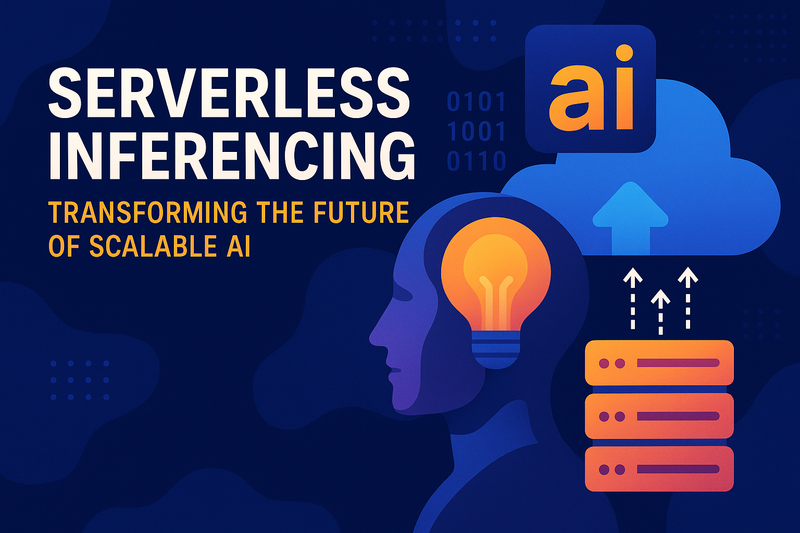Artificial Intelligence (AI) has evolved rapidly in just a few years, fueling innovations across industries from healthcare and finance to retail and logistics. As demand for intelligent applications grows, developers and enterprises face a persistent challenge: how to deploy AI models at scale while keeping infrastructure complexity and costs manageable.
This is where serverless inferencing is beginning to play a vital role.
Traditional AI Deployment vs. Serverless Inferencing
Traditionally, deploying AI models required maintaining dedicated servers or cloud environments that remain active 24/7 to respond to inference requests. For organizations with fluctuating demand, this often resulted in wasteful resource utilization and unnecessary expenses.
Serverless inferencing addresses these limitations by combining the scalability of serverless computing with the power of AI model predictions, offering on-demand performance without heavy operational overhead.
What is Serverless Inferencing?
Serverless inferencing refers to the execution of AI model predictions (or inferences) using a serverless computing framework.
- In a serverless setup, developers do not manage servers directly.
- The cloud provider automatically provisions, scales, and manages compute resources as requests arrive.
- A machine learning model can be deployed as a lightweight function that executes only when triggered (e.g., by user queries, application events, or API calls).
Example: Instead of keeping a GPU-powered instance running continuously, the model is invoked only when a request comes in, and the infrastructure scales up to handle it.
This eliminates wasted compute time and makes the approach cost-efficient for businesses with unpredictable workloads.
Why Serverless Inferencing Matters
The adoption of serverless inferencing is not just a minor optimization—it represents a fundamental shift in AI workload consumption.
1. Scalability Without Hassle
AI applications (recommendation engines, chatbots, fraud detection, image recognition) often face traffic bursts. Serverless automatically scales up during peak requests and scales back down during idle times.
2. Cost Efficiency
Pay-as-you-go billing ensures organizations only pay for compute time used. Perfect for seasonal businesses or workloads with unpredictable demand.
3. Simplified Operations
No need to manage containerization, autoscaling, or monitoring. Developers can focus on improving AI models instead of managing infrastructure.
4. Rapid Experimentation and Deployment
Quickly deploy multiple models for testing, without provisioning delays—accelerating innovation and reducing time-to-market.
Use Cases of Serverless Inferencing
- Healthcare Applications: AI-powered medical imaging that runs only when scans are uploaded.
- Retail & E-commerce: Recommendation engines scaling dynamically during sales seasons.
- Financial Services: Fraud detection models analyzing transactions in real time without idle servers.
- Customer Support: NLP chatbots and assistants running cost-effectively round-the-clock.
Challenges to Consider
Despite its benefits, serverless inferencing comes with trade-offs:
- Cold Start Latency: First requests after idle time can face delays.
- Resource Limits: Constraints on memory, execution time, and concurrency.
- Model Size & Dependencies: Large deep learning models require careful packaging and optimization.
- Vendor Lock-In: Heavy reliance on one provider’s ecosystem may affect portability.
Best Practices for Serverless Inferencing
- Optimize & Compress Models: Use quantization, pruning, and knowledge distillation.
- Leverage Event-Driven Architectures: Trigger inference via events (e.g., new request, file upload).
- Use Specialized Frameworks & Tools: AWS Lambda, Google Cloud Functions, and other managed AI services.
- Plan for Hybrid Architectures: Combine serverless for elasticity with dedicated GPU instances for low-latency needs.
The Road Ahead
As AI models grow in size and complexity, the demand for scalable deployment strategies will intensify. Serverless inferencing promises to:
- Lower operational barriers.
- Improve cost-efficiency.
- Expand accessibility to machine learning capabilities.
Future improvements—like reduced cold start latency, GPU-backed serverless functions, and support for larger models—will make this approach even more compelling.
Conclusion
Serverless inferencing is more than a technical advancement; it’s a practical bridge between AI innovation and real-world deployment.
By marrying the flexibility of serverless computing with the intelligence of AI, it empowers developers and enterprises to:
- Deliver smarter applications.
- Reduce infrastructure costs.
- Scale effortlessly with demand.
As adoption grows, serverless inferencing is poised to become a cornerstone in the AI deployment toolkit, shaping how businesses bring intelligence to their products and services.




Top comments (0)